The Storms of May
This May saw a lot of damage to trees. Those with a weak spot sometimes shattered.
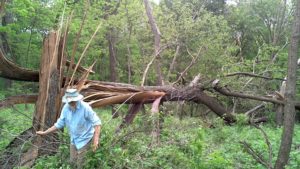
This walnut tree survived a lightning strike a decade ago but it had not healed well and was structurally weak with some internal decay.
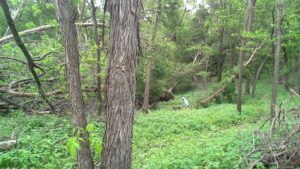
This cherry tree was decayed at the base.
And in addition, the soil in May was so saturated that some tree roots lost their grip on it and simply toppled over in high winds.
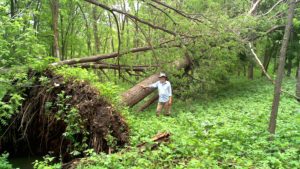
This hackberry tree lost its grip on soggy soil during a storm.
In the eternal battle between forest and prairie, this May’s weather favored prairie.
The nesting season for woodland birds was already underway and they also sustained storm damage. Nests blew down, and took eggs and chicks with them.
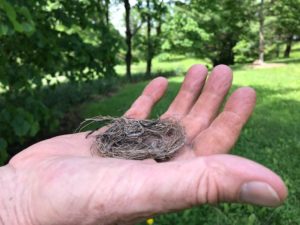
This little nest of plant fibers was flattened by pounding rain into a disc.
For the past three or four decades, a pair of phoebes have nested in the rafters of my tractor carport, where I have inadvertently created nearly perfect nest sites for them, which are predator proof. The little birds have much shorter life spans than that of course, so I suppose that we have been hosting a long chain of phoebe children who have been replacing their parents.
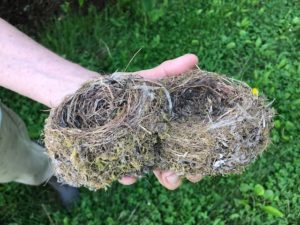
Twin phoebe nests.
This year was unique in that a pair of females built a pair of nests joined at the base into a single unit, which sat on a crossboard below the rafters.
I had never seen this before, but checking Kenn Kaufman’s Lives of North American Birds, he says: “Occasionally one male may have two mates and help feed the young in two nests at once.” The Sibley Guide to Bird Life and Behavior also confirms this. So I started thinking of the females as the Phoebe Sisters, which sounds like a folksong duo.
But our storm of May 16 was a real shredder and next day the twinned nests were on the ground, empty. A few days later one new nest was under construction in the same place.
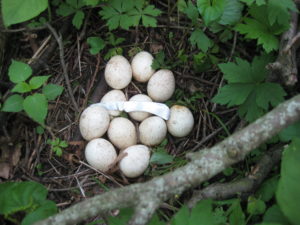
Abandoned turkey eggs, small pocketknife for scale.
Even some ground-nesting woodland birds lost their nests. In our woodlot, a turkey abandoned her eggs.
I do not know whether the eggs got too cold while she was seeking better shelter from the storm (the nest is only a hundred feet from the top of the shattered tree in the first photo), or perhaps she didn’t survive the storm.
The forest/prairie tension zone gets pretty dynamic weatherwise, and this May was hard on trees and their dependents. In some other May, which is sunny and dry, it might be fire that challenges grassland birds, while the woodlands are little affected.
Viewed just today, May’s weather has been a disaster for some trees. But long-term there are many seedlings waiting in the shade for just such a crisis to give them their moment in the sun. And if nests are lost early enough in the season, some birds will immediately try again. Nature is quite resilient regarding natural disasters. In managing native land, we have to be as resilient as the ecosystems we have accepted responsibility for. And like the birds willing to re-nest, we need to accept our failures, learn from them, and move on to do better.


